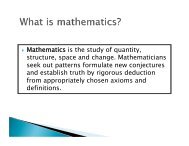View the issue here. - The Gordon School
View the issue here. - The Gordon School
View the issue here. - The Gordon School
- No tags were found...
Create successful ePaper yourself
Turn your PDF publications into a flip-book with our unique Google optimized e-Paper software.
FACULTY SPOTLIGHT SEAN HAMERSean has been teaching seventh grade mathand science at <strong>Gordon</strong> for four years. He isa seventh grade advisor, a facilitator for <strong>the</strong>Middle <strong>School</strong> student affinity group program,and <strong>the</strong> girl’s field hockey and basketballcoach.Sean is a graduate of UMass Boston and earnedhis Masters of Education in Middle <strong>School</strong>Math and Science Education from <strong>the</strong> LesleyUniversity/Shady Hill <strong>School</strong> Teacher TrainingProgram. He has also received his Mastersin Private <strong>School</strong> Leadership from TeachersCollege-Columbia University. Sean’s twochildren Sekou (4th) and Nala (K) are <strong>Gordon</strong>students.What led you to <strong>Gordon</strong>?Although I was originally an engineering major,I ended up focusing much of my time onworking with at-risk youth in Boston. When myson, Sekou was born I realized that I wanted toteach. I earned my M.Ed. degree while teachingat Shady Hill <strong>School</strong> and focused my practiceon teaching Middle <strong>School</strong> math and scienceas it connected to my engineering background.I began my career at Charles River <strong>School</strong> inDover, MA and later made connections with EricPolite, <strong>Gordon</strong>’s former Diversity Director whicheventually led me to this opportunity at <strong>Gordon</strong>.How do you include a multicultural perspectivein your practice?In order to facilitate thoughtful discussionsaround multicultural <strong>issue</strong>s a sense of trust mustbe established between <strong>the</strong> teacher and students.Many of <strong>the</strong> topics we discuss in my classchallenge preconceptions and care needs to betaken when sharing different perspectives.I work hard to set clear community expectationsin <strong>the</strong> beginning of <strong>the</strong> year so that studentshave <strong>the</strong> confidence to state <strong>the</strong>ir opinionsand feel supported when <strong>the</strong>y make mistakes.My philosophy is to guide students towardunderstanding ra<strong>the</strong>r than directing <strong>the</strong>m. I amsupportive and <strong>the</strong>re to provide explanationand clarity but not tell <strong>the</strong>m that <strong>the</strong>ir opinionis right or wrong.My approach to <strong>the</strong> curriculum is to teach<strong>the</strong> skills necessary to understand <strong>the</strong> contentbut to also put my instruction into a relevantcontext. Math and science lend <strong>the</strong>mselves tounderstanding and analyzing <strong>issue</strong>s of equity,justice and inclusion. I challenge my studentswith examples of real world problems so that<strong>the</strong>y can employ <strong>the</strong>ir math and science skillsand become aware of <strong>the</strong> world around <strong>the</strong>m.What are some examples of your math andscience curriculum that have a multiculturalperspective?For <strong>the</strong> past two years we have connected <strong>the</strong>math curriculum to <strong>the</strong> current economic crisis.We look at credit use and why it is such achallenge for Americans. During one project,I assign each student a credit profile (thatincludes a credit score, number of children,income level, etc.), and have <strong>the</strong>m figure outwhat rates and monthly payments <strong>the</strong>y wouldreceive for a home and car loan. As a class wediscuss why people qualify for different loanrates and <strong>the</strong> equity behind that.By looking at credit scores, home loans andinvestments students learn <strong>the</strong> math behindfiguring out compound and simple interestloans and rates. Students learn to record <strong>the</strong>irdata by using excel and data manipulationskills. In <strong>the</strong> end, <strong>the</strong>y learn new math conceptsalong with an understanding of how peopleare impacted by credit.With science, we look at our study of biologyand genetics through <strong>the</strong> lens of equity, race,power and privilege. We study blood typingand blood diseases and how various diseasesare connected to racial and cultural history.We also talk about access to resources inscience and medicine. We discuss how certaincountries are limited by socio-economicdifferences and <strong>the</strong>refore have less access toresources. Students are able to gain a globalperspective by gaining an understanding ofpopulations around <strong>the</strong> world.What do you hope for your students?I hope that my students will continue to thinkdeeply about <strong>the</strong>ir connection to <strong>the</strong> worldaround <strong>the</strong>m. I want <strong>the</strong>m to strive to becomeglobal citizens by developing an awareness andunderstanding of o<strong>the</strong>rs and <strong>the</strong>ir perspectives.6









